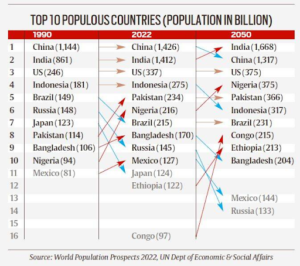About UN WPP-
- The Population Division of the UN has been publishing the WPP in a biennial cycle since 1951.
- Each revision of the WPP provides a historical time series of population indicators starting in 1950.
- It does so by taking into account newly released national data to revise estimates of past trends in fertility, mortality or international migration.
- The 2022 revision provides population estimates for the period 1950-2021. Estimates of stocks are presented for every year.
- Stock estimates refer to either 1 January or 1 July of the year in question. Period estimates may be assumed to refer to the mid-year concerned. Data are presented by single calendar years and either five year age groups or single ages.
- The 2022 revision provides population projections up to 2100.
- There is only one series for the population estimates, but there are several series for the population projections, because different projection scenarios are calculated.
Key Findings-
Following are the key findngs/projection of the report:
The world’s population continues to grow, but the pace of growth is slowing down:
- The global population is expected to grow to around 8.5 billion in 2030, 9.7 billion in 2050 and 10.4 billion in 2100.
- In 2020, the global growth rate fell under 1% per year for the first time since 1950. It has been projected that the world’s population to reach 8 billion on November 15, 2022.
Rates of population growth vary significantly across countries and regions:
- More than half of the projected increase in global population up to 2050 will be concentrated in just eight countries: the Democratic Republic of the Congo, Egypt, Ethiopia, India, Nigeria, Pakistan, the Philippines and the United Republic of Tanzania.
- The 46 least developed countries (LDCs) are among the world’s fastest-growing. Many are projected to double in population between 2022 and 2050, putting additional pressure on resources and posing challenges to the achievement of the UN’s Sustainable Development Goals (SDGs).
The population of older persons is increasing both in numbers and as a share of the total:
- The share of the global population aged 65 years or above is projected to rise from 10% in 2022 to 16% in 2050.
- A sustained drop in fertility has led to an increased concentration of the population at working ages (between 25 and 64 years), creating an opportunity for accelerated economic growth per capita: This shift in the age distribution provides a time-bound opportunity for accelerated economic growth known as the “demographic dividend”. “
International migration is having important impacts on population trends for some countries:
- For high-income countries between 2000 and 2020, the contribution of international migration to population growth (net inflow of 80.5 million) exceeded the balance of births over deaths (66.2 million).
- Over the next few decades, migration will be the sole driver of population growth in high-income countries.
- For 10 countries, the estimated net outflow of migrants exceeded 1 million over the period from 2010 through 2021.
- In many of these countries, the outflows were due to temporary labour movements, such as for Pakistan (net flow of -16.5 million), India (-3.5 million), Bangladesh (-2.9 million), Nepal (-1.6 million) and Sri Lanka (-1.0 million).
- In other countries, including the Syrian Arab Republic (-4.6 million), Venezuela (Bolivarian Republic of) (-4.8 million) and Myanmar (-1.0 million), insecurity and conflict drove the outflow of migrants over this period.

Key findings related to India-
- According to the 2022 edition, India is projected to surpass China as the world’s most populous country in 2023.

- The concern now is not about the absolute numbers — India’s population is already 1.4 billion and may go up to 1.6 billion before declining.
- Looking at the India data, it is clear that as things stand, cohorts of 0-14 years and 15-24 years will continue to decline while those of 25-64 and 65+ will continue to rise for the coming decades.
- Note: In India, the Registrar General comes out with a population projection based on the Census. The last such projection was released in 2019 and it was based on Census 2011.
















